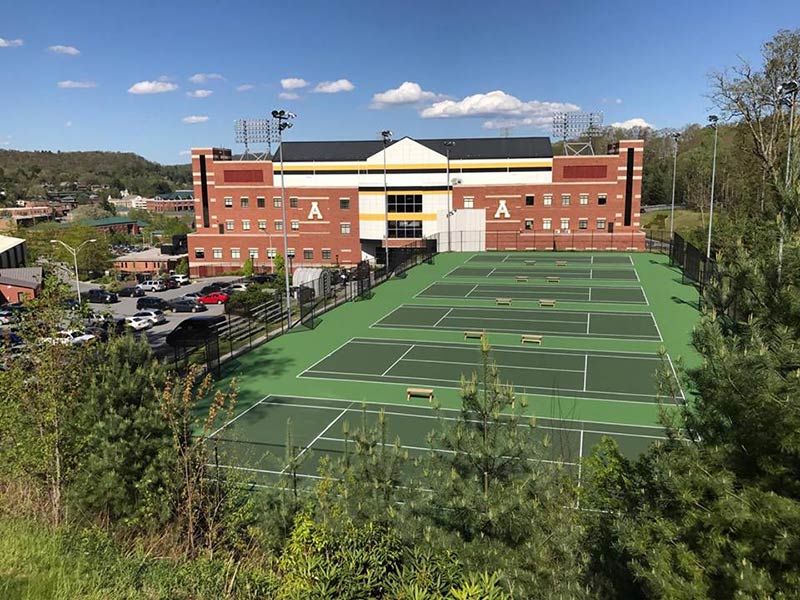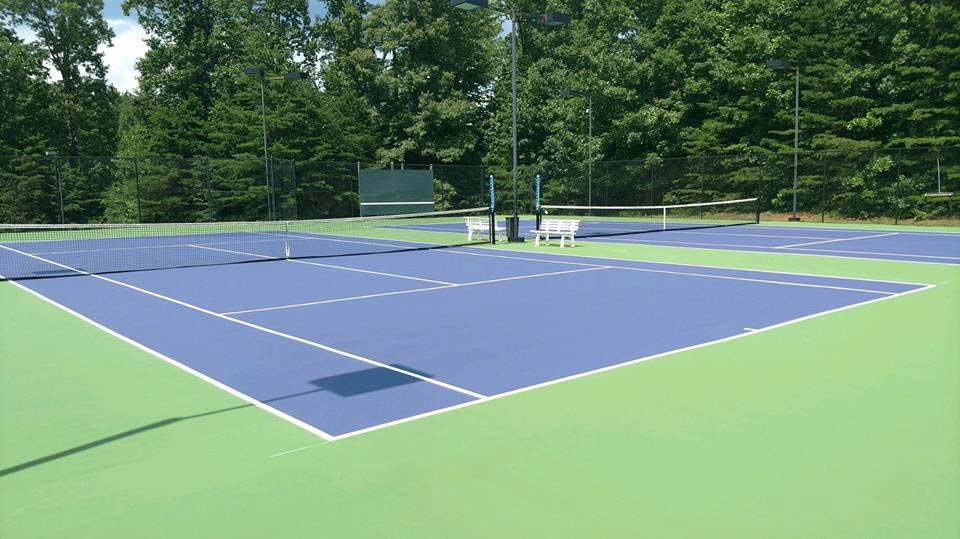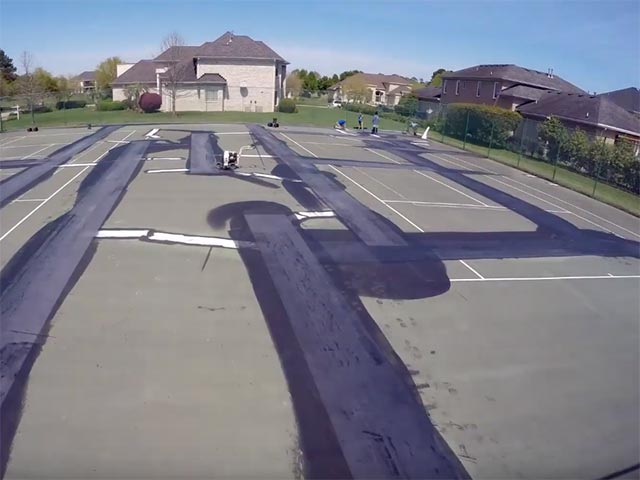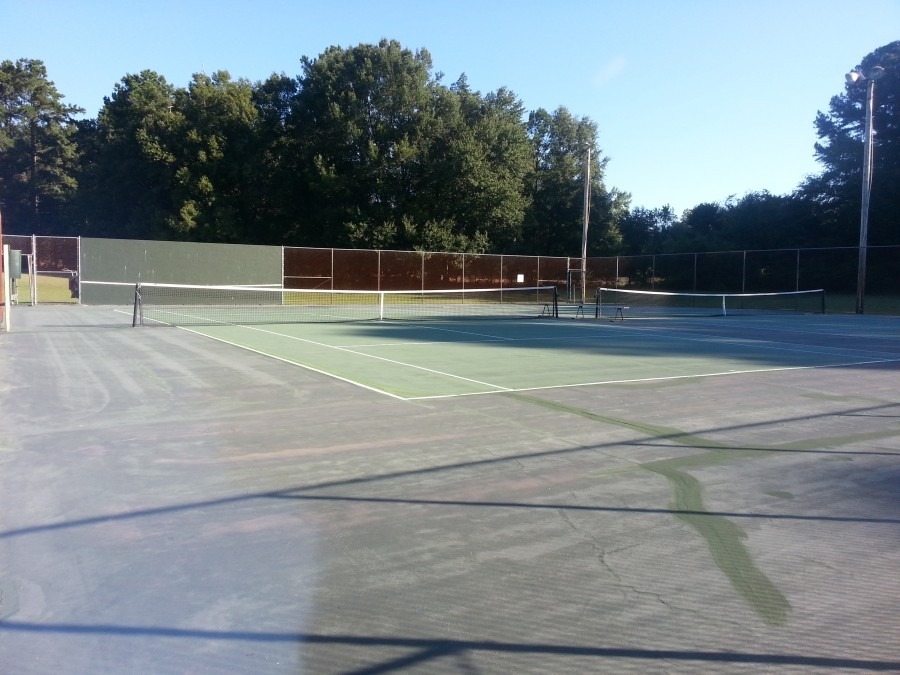For over 30 years, the licensed tennis court resurfacing contractors at North State Resurfacing have been turning cracked, dilapidated tennis courts into flat, level, smooth surfaces. We are proud of our extensive portfolio of work that covers all corners of North Carolina, including Raleigh, Greensboro, and Charlotte. We also service parts of southern Virginia, and northern South Carolina.
Our happy customers come from a variety of different spaces, including apartment complexes, resorts, public parks, private residences, government installations, military bases, schools, universities, and more.
If you are ready to restore your tennis court to its former glory with top of the line court refinishing services, call our friendly repair and refacing experts today.
Why Resurface Your Tennis Court?
Tennis courts endure significant wear and tear over time, making resurfacing a crucial maintenance step. Worn down tennis courts have tired surfaces marred by cracks, unevenness, and compromised grip. In their current condition, they present significant challenges for players and facility owners alike.
Our expertise in tennis court resurfacing goes beyond mere aesthetics, focusing on optimizing performance and ensuring a safer playing environment. By addressing underlying issues with meticulous attention to detail and advanced techniques, we not only reduce maintenance costs but also extend the lifespan of the courts, ultimately enhancing user satisfaction.
Embrace the opportunity to rejuvenate your worn-out tennis courts and unlock their true potential with our resurfacing expertise. Here are some compelling reasons to resurface your NC, VA, or SC tennis court or pickleball court with our refacing solutions.

Enhanced Performance
Our expert tennis court resurfacing techniques optimize traction, providing superior grip and stability for swift movements and precise shots. A newly resurfaced tennis court provides a smoother, more even playing surface, improving ball bounce consistency and player performance. This ensures an optimal playing experience for both recreational players and competitive athletes.
Increased Safety
By refreshing the worn-out surface, you create a secure environment that minimizes the risk of accidents and injuries. The elimination of cracks, bumps, and uneven textures ensures a smooth playing surface, allowing players to move with confidence and agility.
Extended Court Lifespan
Regular resurfacing helps to preserve the structural integrity of your tennis court. By addressing minor damages early, you can prevent them from escalating into major issues, thereby extending the overall lifespan of your court.
Improved Aesthetics
A fresh coat of surfacing material revitalizes the appearance of your tennis court, making it look brand new. This can enhance the visual appeal of your facility, whether it’s a private court, a community center, or a professional sports venue.
Better Drainage and Performance
Resurfacing often includes improvements to the court’s drainage system, preventing water accumulation, which can lead to mold and mildew growth. This ensures that your court remains playable in various weather conditions, maintaining its performance standards and reducing downtime after rain.
Increased Property Value
For homeowners or facilities with tennis courts, regular maintenance, including resurfacing, can significantly boost property value. A well-maintained court is a desirable feature that adds to the overall appeal and marketability of your property.
Resurfacing your tennis court is an investment in safety, aesthetics, and longevity. It not only enhances the playing experience but also ensures that your court remains in top condition for years to come. Whether for personal use or public enjoyment, a well-maintained tennis court surface is always a valuable asset.
Beyond Tennis Court Repair and Crack Filling
Our tennis court resurfacing experts are skilled at repairs and techniques to fill cracks or smooth surfaces. However, in addition to our top-quality maintenance services, our team at North State Resurfacing are pros at enhancing your North Carolina, Virginia, or South Carolina tennis court surfaces in other ways.

Add Color to Your Existing Surface
Adding color can make your tennis court stand out and add curb appeal. Many people don’t realize the color options available to them when it comes to their tennis courts. North State Resurfacing can inform you about your choices so you can pick the surface color that best suits your style.
Blended Lines for Multi-Surface Courts
Take advantage of the current tennis court trends without losing space. By adding blended lines to your court’s surface, you can use your tennis court as a pickleball court, basketball court, or a court for another sport, allowing you to keep guests and players on the courts no matter what their preferred game is.
Recent Tennis Court Resurfacing Projects
Check out our recent tennis court resurfacing projects to get some ideas for your court!
Recent Tennis Court Resurfacing Projects
Tennis Court Resurfacing Materials
As asphalt ages, it loses flexibility. This loss of flexibility adds a level of vulnerability to the pavement, especially under extreme weather conditions. When exposed to the elements, outdoor tennis courts will expand and contract in congruence with the outside air temperature, causing the inevitable occurrence of cracks along the surface.
Acrylic Resurfacer for Tennis Courts
When repairing asphalt tennis court surfaces, a substance called Acrylic Resurfacer is used for preparing new surfaces and color coating. This substance is made of a 100% acrylic latex binder.

When introduced to silica sand, acrylic resurfacer can then be used to remedy a cracked and damaged tennis court surface. The quality of the resurfacer mix relies heavily on the type of sand used. The mix should not contain clay or salt materials. It is also important to not over dilute the material. An effective mix will make sure not to dilute past two-fifths of the Acrylic resurfacer with water. Over-dilution leads to visible streaking, failure for the adhesion to take hold, and low durability of the coating.
Preparing to Apply the Resurfacer to the Tennis Court
In order to prepare your tennis court for the acrylic resurfacer, its important for the following steps to be taken:
- Before an acrylic resurfacer can be applied, the tennis court must be free of all dirt, residue, debris, or oily material. This is to ensure that the adhesive properly covers the court without any interference.
- Priming may be necessary for asphalt courts that are too damaged and weathered to connect properly with the acrylic bond. Primers are used to progress the adhesion effect of the resurfacer.
- Once the sand and water have been introduced to the Acrylic mix, the next step is meticulous mixing. This is usually done with a mechanical drill in order to make sure the mixture is uniform.
The Process of Applying Acrylic Resurfacer to Your Tennis Court
Once mixed properly, the resurfacer is positioned and spread along the tennis court’s surface with a squeegee. This process requires a lot of training and is nowhere as easy as it looks, therefore, it’s important to hire a professional tennis court resurfacing company for a professional job.
The resurfacer must be allowed to sit for at least two hours after being applied before the acrylic coating can be introduced.
Necessary Weather Conditions for Tennis Court Resurfacing
In order to work properly, some environmental conditions must be met. For instance, Acrylic resurfacer contains a high concentration of water, so it should not be allowed to freeze in storage. Because of this, tennis court resurfacing projects should not be conducted during rainfall or when rainfall is forthcoming.
Drying times can be affected by high humidity, cooler temperatures, and insufficient air movement. The air temperature should be above sixty degrees Fahrenheit and below 140 degrees Fahrenheit. Fun fact: the highest air temperature ever recorded on Earth was 134 degrees in Death Valley in 1913, so the upper end of the temperature range doesn’t really come into play unless the heat is so severe it threatens the health and safety of our team.
How Often Should You Resurface Your Tennis Court?
Tennis courts should generally need to be resurfaced about every 5 years. This varies based on a number of factors, including:
- Who is playing: First of all, there is the question of who is playing on the tennis court and what standard of play you are willing to accept. Are there multi-million dollar athletes playing on your court? If so, your tennis courts better should be flawlessly maintained at all times. If everyday folks like you and I are the clientele, some tiny cracks may very well be acceptable.
- Budget: Obviously budget is also a deciding factor. If a small municipality can’t afford to resurface its tennis courts more than once a decade, it may still successfully serve as a place to play and have fun for the local kids.
- Frequency of play: The frequency in which a court should be resurfaced differs from court to court. There is no standard interval of time in which every tennis court must be resurfaced. There are, however, certain variables to consider when determining how long you should wait to resurface your court.
Conditions Leading to Deterioration of Tennis Court Surfaces
Some tennis court surfaces age better than others, and there’s usually a reasonable answer as to why that is.
Your tennis court may need resurfacing services prior to its five year maintenance needs if any of the following conditions exist:

- If your court has an improper slope, it could lead to water collecting in certain areas. This advances the breakdown of acrylic surfaces. Moisture damage can cause cracks and premature surface blemishes.
- An unsatisfactory drainage system or insufficient compaction can cause surface bubbles and/or depressions (known as “birdbaths”), as well as deformities along the court’s exterior.
- Untrimmed grass along a court’s edges acts as a wall that causes a backup of water that would naturally drain off the court. This accumulation of water gradually scrapes at the acrylic surface coating, leading to accelerated deterioration.
- Environmental conditions can play a role in the quality of the color coating. Organic materials such as leaves and pine needles build upon a court’s surface. These materials hold moisture and can deteriorate the tennis court surface. Issues such as these can play a large role in determining how often a court needs to be resurfaced.
High construction standards can minimize or delay cracking, but eventually, every tennis court will need to be resurfaced. When that time arises, be sure to contact your experts at North State who have been resurfacing tennis courts, basketball courts, pickleball courts, and multi-use courts throughout North Carolina, Virginia, and South Carolina for over 30 years.
Pullen Park
Wake Forest University – Tennis Courts, Winston-Salem NC
Alamance Country Club – Tennis Courts, Burlington NC
Biltmore Hills Park, Raleigh NC
Mike’s Sweet Mustache!
Private Residence
HOA Tennis Court, Southport NC
Camp Lejeune, Jacksonville NC
Cedar Hills Park
Three Colonies Community, Fayetteville NC
Tarboro Parks and Recreation, Tarboro NC
Tennis & Pickleball Court Resurfacing, Oak Island NC
Tennis Court Resurfacing, Farmville NC
Grandover Swim & Racquet Club
Appalachian State University, Boone NC
Private Residence – Lake Norman, Charlotte NC
Lake Lynn
Fred Fletcher Park
Private Tennis Court, Wilkesboro NC
Laurel Park HOA, Concord NC
Tennis Court Resurfacing Aero Plantation, Waxhaw NC
Riverside Community Association
American Hebrew Academy
SeaWatch Tennis Court, Kure Beach NC
West Davidson High School, Lexington NC
East Chapel Hill High School, Chapel NC
North Topsail Beach, Topsail NC
Fairgate Apartment Homes, Raleigh NC
Town of Pembroke Tennis Courts
Six Tennis Courts, High Point NC
Glen Eden Pilot Park
The Village Apartments
Covil Estates
Cypress Island Neighborhood
Shallotte Park
Holden Beach
South Brunswick High School
Wendell Park Tennis Court Resurfacing
Private Residence, Norfolk VA
Wildwoods of Lake Johnson, Raleigh NC
Acrylic Tennis Court, Charlotte NC
Tennis Court Resurfacing, Apex NC
Pinehurst Tennis & Pickleball Court
Jaycee Park
Cardinal Gibbons High School Tennis Courts, Raleigh NC
Union Pines High School, Cameron NC
Tennis Courts in Winston-Salem NC
Knightdale High School Tennis Courts, Knightdale NC
Sunalei Preserve Tennis Courts, Zionville NC
Stonecreek Tennis Courts, Raleigh NC
Southern Village Tennis Courts, Chapel Hill NC
Athens Drive High School Tennis Courts, Raleigh NC
Bur-Mill Park Tennis Courts
Highlands At Olde Raleigh Tennis Courts, Raleigh NC
Mallard Cove Road Tennis Courts, Sanford NC
Elon University – Tennis Courts, Elon NC
Ayden Parks & Recreation Department, Ayden NC
Transform Your Tennis Court with Our Resurfacing Experts
Resurface your tennis court with the experts at North State Resurfacing. Our team specializes in revitalizing tennis courts to enhance playability, safety, and aesthetics. Don’t let wear and tear diminish your tennis experience—contact us today to bring your court back to life.
With our expertise and commitment to quality, we ensure your court is safe, visually appealing, and built to last. Contact us today for a consultation and take the first step towards a superior playing surface. Get started now by calling us at (919) 365-7500 or clicking below

